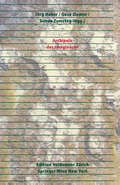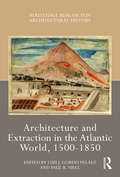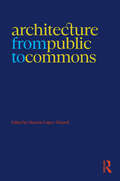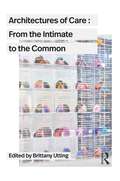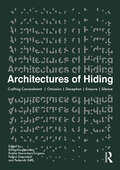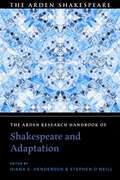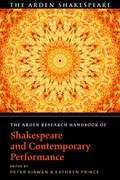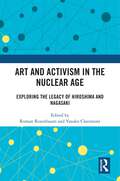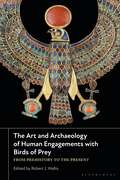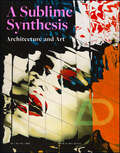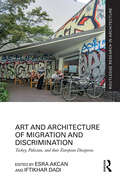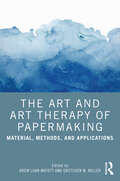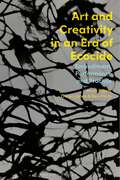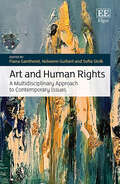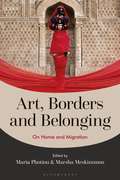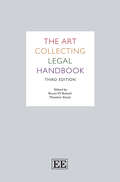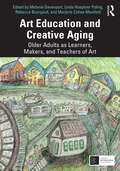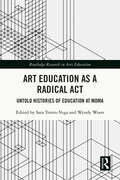- Table View
- List View
Arabesque without End: Across Music and the Arts, from Faust to Shahrazad (Music and Visual Culture)
Featuring multidisciplinary research by an international team of leading scholars, this volume addresses the contested aspects of arabesque while exploring its penchant for crossing artistic and cultural boundaries to create new forms. Enthusiastically imported from its Near Eastern sources by European artists, the freely flowing line known as arabesque is a recognizable motif across the arts of painting, music, dance, and literature. From the German Romantics to the Art Nouveau artists, and from Debussy’s compositions to the serpentine choreographies of Loïe Fuller, the chapters in this volume bring together cross-disciplinary perspectives to understand the arabesque across both art historical and musicological discourses.
Archipele des Imaginären (Edition Voldemeer Zürich)
Der Begriff des Imaginären ist geprägt von einer langen und komplexen Geschichte. Der Band "Archipele des Imaginären" strebt nicht nach einer Vereinfachung dieser Komplexität. Vielmehr werden in vier Schwerpunkten (Archipel des Unsichtbaren, Archipel der Regel, Archipel des Schwindels, Archipel der Peinlichkeit) unterschiedliche (Theorie-)Horizonte in ein Verhältnis wechselseitiger Erhellung gerückt. Die in diesem Band versammelten Beiträge kreisen um einen für Theorie und Praxis der Gestaltung zentralen Begriff, um das Imaginäre, das in seiner Ambivalenz das Neue (respektive dessen Wahrnehmung) sowohl blockieren als auch für seine Schöpfung und Entstehung verantwortlich zeichnen kann.
Architecture and Extraction in the Atlantic World, 1500-1850 (Routledge Research in Architectural History)
This edited collection examines the development of Atlantic World architecture after 1492. In particular, the chapters explore the landscapes of extraction as material networks that brought people, space, and labor together in harvesting raw materials, cultivating agriculture for export-level profits, and circulating raw materials and commodities in Europe, Africa, and the Americas from 1500 to 1850. This book argues that histories of extraction remain incomplete without careful attention to the social, physical, and mental nexus that is architecture, just as architecture’s development in the last 500 years cannot be adequately comprehended without attention to empire, extraction, colonialism, and the rise of what Immanuel Wallerstein has called the world system. This world system was possible because of built environments that enabled resource extraction, transport of raw materials, circulation of commodities, and enactment of power relations in the struggle between capital and labor. Separated into three sections: Harvesting the Environment, Cultivating Profit, and Circulating Commodities: Networks and Infrastructures, this volume covers a wide range of geographies, from England to South America, from Africa to South Carolina. The book aims to decenter Eurocentric approaches to architectural history to expose the global circulation of ideas, things, commodities, and people that constituted the architecture of extraction in the Atlantic World. In focusing on extraction, we aim to recover histories of labor exploitation and racialized oppression of interest to the global community. The book will be of interest to researchers and students of architectural history, geography, urban and labor history, literary studies, historic preservation, and colonial studies.
Architecture from Public to Commons
This book provides an urgent framework and collective reflection on understanding ways to reconsider and recast architecture within ideas and politics of the commons and practices of commoning. Architecture from Public to Commons opens with Institutions the dialogue with the scales of the commons, the limits of language for fluid identities, the practices and challenges of architecture as an institution, the design of objects with apparent shared value in Chile, land protocols that explore alternatives to profit-seeking of property in New York, and spirited conversations about revolting against architectural labor from Latin America. Continuing chapters explore, under Territories, the boundaries of Blackness across the Atlantic between Ethiopia and Atlanta, the underground woven network with conflicting grounds of ipê wood between Brazil and the US, water cycles in depleted territories in Chile, indigenous women-led territorial and human rights struggles in Guatemala, climate change accidental commons in California, and the active search for racial justice between design and place in New Orleans. Contributions range from theoretical and historical essays to current case studies of on-the-ground practices in the US, the Middle East, Europe, and Central and South America. Bringing together architects, scholars, artists, historians, sociologists, curators, and activists, this book instils an urgent framework and renewed set of tools to pivot from architecture’s traditional public to a politicized commons. It will greatly interest students, academics, and researchers in architecture, urban design, architectural theory, landscape architecture, political economy, and sociology.
Architecture Thinking across Boundaries: Knowledge transfers since the 1960s
While most studies on the history of architectural theory have been concerned with what has been said and written, this book is concerned with how architecture theory has been created and transmitted.Architecture Thinking across Boundaries looks at architectural theory through the lens of intellectual history. Eleven original essays explore a variety of themes and contexts, each examining how architectural knowledge has been transferred across social, spatial and disciplinary boundaries - whether through the international circulation of ideas, transdisciplinary exchanges, or transfers from design practice to theory and back again. Dissecting the frictions, transformations and resistances that mark these journeys, the essays in this book reflect upon the myriad routes that architectural knowledge has taken while developing into architectural theory. They critically enquire the interstices – geographical, temporal and epistemological – that lie beyond fixed narratives. They show how unstable, vital and eminently mobile the processes of thinking about architecture have been.
Architectures of Care: From the Intimate to the Common
Drawing from a diverse range of interdisciplinary voices, this book explores how spaces of care shape our affective, material, and social forms, from the most intimate scale of the body to our planetary commons.Typical definitions of care center around the maintenance of a livable life, encompassing everything from shelter and welfare to health and safety. Architecture plays a fundamental role in these definitions, inscribed in institutional archetypes such as the home, the hospital, the school, and the nursery. However, these spaces often structure modes of care that prescribe gender roles, bodily norms, and labor practices. How can architecture instead engage with an expanded definition of care that questions such roles and norms, producing more hybrid entanglements between our bodies, our collective lives, and our environments? Chapters in this book explore issues ranging from disabled domesticities and nursing, unbuilding whiteness in the built environment, practices and pedagogies of environmental care, and the solidarity networks within ‘The Cloud’. Case studies include Floating University Berlin, commoning initiatives by the Black Panther party, and hospitals for the United Mine Workers of America, among many other sites and scales of care.Exploring architecture through the lenses of gender studies, labor theory, environmental justice, and the medical humanities, this book will engage students and academics from a wide range of disciplines.
Architectures of Display: Department Stores and Modern Retail (Routledge Research in Interior Design)
Through an international range of case studies from the 1870s to the present, this volume analyzes strategies of display in department stores and modern retail spaces. Established scholars and emerging researchers working within a range of disciplinary contexts and historiographical traditions shed light on what constitutes modern retail and the ways in which interior designers, architects, and artists have built or transformed their practice in response to the commercial context.
Architectures of Hiding: Crafting Concealment | Omission | Deception | Erasure | Silence
Architecture manifests as a space of concealment and unconcealment, lethe and alêtheia, enclosure and disclosure, where its making and agency are both hidden and revealed. With an urgency to amplify narratives that are overlooked, silenced and unacknowledged in and by architectural spaces, histories and theories, this book contends the need for a critical study of hiding in the context of architectural processes. It urges the understanding of inherent opportunities, power structures and covert strategies, whether socio-cultural, geo-political, environmental or economic, as they are related to their hidescapes – the constructed landscapes of our built environments participating in the architectures of hiding. Looking at and beyond the intentions and agency that architects possess, architectural spaces lend themselves as apparatuses for various forms of hiding and un(hiding). The examples explored in this book and the creative works presented in the interviews enclosed in the interludes of this publication cover a broad range of geographic and cultural contexts, discursively disclosing hidden aspects of architectural meaning. The book investigates the imaginative intrigue of concealing and revealing in design processes, along with moral responsibilities and ethical dilemmas inherent in crafting concealment through the making and reception of architecture.
The Arden Research Handbook of Shakespeare and Adaptation (The Arden Shakespeare Handbooks)
The Arden Research Handbook of Shakespeare and Adaptation explores the dynamics of adapted Shakespeare across a range of literary genres and new media forms. This comprehensive reference and research resource maps the field of Shakespeare adaptation studies, identifying theories of adaptation, their application in practice and the methodologies that underpin them. It investigates current research and points towards future lines of enquiry for students, researchers and creative practitioners of Shakespeare adaptation. The opening section on research methods and problems considers definitions and theories of Shakespeare adaptation and emphasises how Shakespeare is both adaptor and adapted.A central section develops these theoretical concerns through a series of case studies that move across a range of genres, media forms and cultures to ask not only how Shakespeare is variously transfigured, hybridised and valorised through adaptational play, but also how adaptations produce interpretive communities, and within these potentially new literacies, modes of engagement and sensory pleasures. The volume's third section provides the reader with uniquely detailed insights into creative adaptation, with writers and practice-based researchers reflecting on their close collaborations with Shakespeare's works as an aesthetic, ethical and political encounter. The Handbook further establishes the conceptual parameters of the field through detailed, practical resources that will aid the specialist and non-specialist reader alike, including a guide to research resources and an annotated bibliography.
The Arden Research Handbook of Shakespeare and Contemporary Performance (The Arden Shakespeare Handbooks)
The Arden Research Handbook of Shakespeare and Contemporary Performance is a wide-ranging, authoritative guide to research on Shakespeare and performance studies by an international team of leading scholars. It contains chapters on the key methods and questions surrounding the performance event, the audience, and the archive – the primary sources on which performance studies draws. It identifies the recurring trends and fruitful lines of inquiry that are generating the most urgent work in the field, but also contextualises these within the histories and methods on which researchers build. A central section of research-focused essays offers case studies of present areas of enquiry, from new approaches to space, bodies and language to work on the technologies of remediation and original practices, from consideration of fandoms and the cultural capital invested in Shakespeare and his contemporaries to political and ethical interventions in performance practice. A distinctive feature of the volume is a curated section focusing on practitioners, in which leading directors, writers, actors, producers, and other theatre professionals comment on Shakespeare in performance and what they see as the key areas, challenges and provocations for researchers to explore.In addition, the Handbook contains various sections that provide non-specialists with practical help: an A-Z of key terms and concepts, a guide to research methods and problems, a chronology of major publications and events, an introduction to resources for study of the field, and a substantial annotated bibliography. The Arden Research Handbook of Shakespeare and Contemporary Performance is a reference work aimed at advanced undergraduate and graduate students as well as scholars and libraries, a guide to beginning or developing research in the field, and an essential companion for all those interested in Shakespeare and performance.
Art and Activism in the Nuclear Age: Exploring the Legacy of Hiroshima and Nagasaki
This book explores the contemporary legacy of Hiroshima and Nagasaki following the passage of three quarters of a century, and the role of art and activism in maintaining a critical perspective on the dangers of the nuclear age. It closely interrogates the political and cultural shifts that have accompanied the transition to a nuclearized world. Beginning with the contemporary socio-political and cultural interpretations of the impact and legacy of the destruction of Hiroshima and Nagasaki, the chapters examine the challenges posed by committed opponents in the cultural and activist fields to the ongoing development of nuclear weapons and the expanding industrial uses of nuclear power. It explores how the aphorism that ‘all art is political’ is borne out in the close relation between art and activism. This multi-disciplinary approach to the socio-political and cultural exploration of nuclear energy in relation to Hiroshima/Nagasaki via the arts will be of interest to students and scholars of peace and conflict studies, social political and cultural studies, fine arts, and art and aesthetic studies.
The Art and Archaeology of Human Engagements with Birds of Prey: From Prehistory to the Present
Of all avian groups, birds of prey in particular have long been a prominent subject of fascination in many human societies. This book demonstrates that the art and materiality of human engagements with raptors has been significant through deep time and across the world, from earliest prehistory to Indigenous thinking in the present day. Drawing on a wide range of global case studies and a plurality of complementary perspectives, it explores the varied and fluid dynamics between humans and birds of prey as evidenced in this diverse art-historical and archaeological record. From their depictions as powerful beings in visual art and their important roles in Indigenous mythologies, to the significance of their body parts as active agents in religious rituals, the intentional deposition of their faunal remains and the display of their preserved bodies in museums, there is no doubt that birds of prey have been figures of great import for the shaping of human society and culture. However, several of the chapters in this volume are particularly concerned with looking beyond the culture–nature dichotomy and human-centred accounts to explore perspectival and other post-humanist thinking on human–raptor ontologies and epistemologies. The contributors recognize that human–raptor relationships are not driven exclusively by human intentionality, and that when these species meet they relate-to and become-with one another. This 'raptor-with-human'-focused approach allows for a productive re-framing of questions about human–raptor interstices, enables fresh thinking about established evidence and offers signposts for present and future intra-actions with birds of prey.
Art and Architecture: A Sublime Synthesis (Architectural Design)
The link between architecture and art and the sublimity it can create has a history that stretches back millennia. From cave paintings to the stained glass and saintly icons in churches and cathedrals, to the geometric and calligraphic treatments of mosques and contemporary artists channelling architecture and vice versa, and so much else. This AD is about the contemporary interactions between living artists and architects, and the artistic practices, such as poetry and abstractions, that architects adopt to develop ideas for their projects. The issue features artists, architects, curators, musicians, poets and designer craftspeople, illustrating the current rich mix of architectonic constructions, interventions and set pieces that range from musical performance to exhibition designs, glass works and digital 3D scanning. It lays out the wide spectrum and beauty of these sublime correspondences, with contributions from architects about their own artistic practices, and creative works viewed through the eyes of architectural commentators. An explosion of colour, form and creative tactics for making multifaceted work that above all is architectural, it offers a cornucopia of possibilities. Contributors: Peter Baldwin, Kathy Battista, Nic Clear, Mathew Emmett, Paul Finch, Paul Greenhalgh, Hamed Khosravi, Eva Menuhin, Felix Robbins, and Simon Withers. Featured architects and artists: a-project, Captivate, Brian Clarke, Andy Goldsworthy, Barbara Hepworth, Danny Lane, Ben Johnson, Brendan Neiland, Ian Ritchie, and Zoe Zenghelis.
Art and Architecture of Migration and Discrimination: Turkey, Pakistan, and their European Diasporas (Routledge Research in Architecture)
This book brings together essays by established and emerging scholars that discuss Pakistan, Turkey, and their diasporas in Europe. Together, the contributions show the scope of diverse artistic media, including architecture, painting, postcards, film, music, and literature, that has responded to the partitions of the twentieth century and the Muslim diasporas in Europe. Turkey and Pakistan have been subject to two of the largest compulsory population transfers of the twentieth century. They have also been the sites for large magnitudes of emigration during the second half of the twentieth century, creating influential diasporas in European cities such as London and Berlin. Discrimination has been both the cause and result of migration: while internal problems compelled citizens to emigrate from their countries, blatant discriminatory and ideological constructs shaped their experiences in their countries of arrival. Read together, the Partition emerges from the essays in Part I not as a pathology specific to the Balkans, Middle East, or South Asia, but as a central problematic of the new political realities of decolonization and nation formation. The essays in Part II demonstrate the layered histories and multiple migration paths that have shaped the experiences of Berliners and Londoners. This analysis furthers the study of modernism and migration across the borders of, not only the nation-state, but also class, race, and gender. As a result, this book will be of interest to a broad multidisciplinary academic audience including students and faculty, artists, architects and planners, as well as non-specialist general public interested in visual arts, architecture and urban literature.
The Art and Art Therapy of Papermaking: Material, Methods, and Applications
The Art and Art Therapy of Papermaking: Material, Methods, and Applications provides a comprehensive collection about the contemporary practices, media, and value of hand papermaking as social engagement, art therapy, and personal voice. Divided into three parts that highlight each of these areas, contributors explore topics such as advocacy, work with survivors, community outreach, medical challenges, and how papermaking can empower creative expression, stories of change, recovery, and reclamation to address trauma, grief and loss, social action, and life experiences. Previous books have covered hand papermaking or art therapy media as stand-alone subjects; this text is the first of its kind that unites and describes the convergence of papermaking in all these forms. Art therapists, art educators, and artists will find this book essential to their education about how papermaking can be a powerful process to make meaning for the self, groups, and community.
Art and Biotechnology: Viral Culture from CRISPR to COVID (Biotechne: Interthinking Art, Science and Design)
This interdisciplinary anthology examines the relationship between developments in biotechnology and both artistic and literary innovation, focussing in particular on how newfound molecular technologies and knowledge regimes, such as CRISPR gene editing, alter conceptions of what it means to be human.The book presents 21 essays, split across four parts, from a coterie of artists, theorists, historians and scientists which examine the symbiotic relationship between humans, animals, and viruses as well as the impossibility of germ-free existence.The essays in this volume are urgent in their topicality, embodying the exhilarating yet alarming zeitgeist of contemporary nonhuman-to-human viral transmission and gene editing technologies. Ultimately, Art and Biotechnology reveals how art and biotechnology influence each other and how art has shaped the discussion around gene editing and the socio-cultural aspects of the Covid-19 pandemic. It is essential reading for students and researchers focussing on science and art, environmental humanities, and ethics.
Art and Creativity in an Era of Ecocide: Embodiment, Performance and Practice
What can creativity achieve in an era of ecocide? How are people using creative and artistic practices to engage with (and resist) the destruction of life on earth? What are the relationships between creativity and repair in the face of escalating global environmental crises? Across twelve compelling case studies, this book charts the emergence of diverse forms of artistic practice and brings together accounts of how artists, scholars and activists are creatively responding to environmental destruction.Highlighting alternative approaches to creativity in both conventional art settings and daily life, the book demonstrates the major influence that ecological thought has had on contemporary creative practices. These are often more concerned with subtle processes of feeling, experience and embodiment than they are with charismatic 'eco-art' works. In doing so, this exploratory book develops a conception of creativity as an anti-ecocide endeavour, and provides timely theoretical and practical insights on art in an age of environmental destruction.
Art and Human Rights: A Multidisciplinary Approach to Contemporary Issues
This timely book builds bridges between the notions of art and aesthetics, human rights, universality, and dignity. It explores a world in which art and justice enter a discussion to answer questions such as: can art translate the human experience? How does humanity link individuality and community building? How do human beings define and look for their identity? The fields of human rights and art are brought together in order to open the discussion and contribute to the promotion and protection of human rights.This interdisciplinary book brings together experts in the fields of art, cultural heritage, social justice, human rights, international law, and transitional justice, and presents the idea that a complex interplay between morality, politics, law, and aesthetics remains present in concrete settings such as the rights of cultural creators, the right to artistic expression, art as a catalyst of change in times of conflict, and post-conflict restitutions. The book offers vignettes of current debates in art and human rights, tackling issues at the confluence of these fields by providing a general framework upon which the conversation can be built, and by bringing to the discussion a diverse range of contemporary themes and concrete case analyses.This book will be an ideal read for academics interested in international law, transitional justice and human rights. Historians, lawyers, artists, and activists looking to explore the relationship between art and human rights in times of war, peace, and transition through their assessment of contemporary issues will also benefit from this comprehensive book.
Art and Modernism in Socialist China: Unexplored International Encounters 1949–1979 (Routledge Research in Art History)
This edited volume will be the first book examining the art history of China’s socialist period from the perspective of modernism, modernity, and global interactions.The majority of chapters are based on newly available archival materials and fresh critical frameworks/concepts. By shifting the frame of interpretation from socialist realism to socialist modernity, this study reveals the plurality of the historical process of developing modernity in China, the autonomy of artistic agency, and the complexity of an art world conditioned, yet not completely confined, by its surrounding political and ideological apparatus. The unexpected global exchanges examined by many of the authors in this study and the divergent approaches, topics, and genres they present add new sources and insights to this research field, revealing an art history that is heterogeneous, pluralistic, and multi-layered.The book will be of interest to scholars working in art history, art and politics, and Chinese studies.
Art, Anthropology, and Contested Heritage: Ethnographies of TRACES
This book presents innovative ethnographic perspectives on the intersections between art, anthropology, and contested cultural heritage, drawing on research from the interdisciplinary TRACES project (funded by the EU's Horizon 2020 program). The case studies in this volume critically assess how and in which arrangements artistic/aesthetic methods and creative everyday practices contribute to strengthening communities both culturally and economically. They also explore the extent to which these methods emphasize minority voices and ultimately set in motion a process of reflexive Europeanisation from below which unfolds within Europe and beyond its borders. At the heart of the book is the development of a new way of transmitting contentious cultural heritage, which responds to the present situation in Europe of unstable political conditions and a sense of Europe in crisis. With chapters looking at difficult art exhibitions on colonialism, death masks, Holocaust memorials, and skull collections, the contributors articulate a response to the crisis in current economic-political conditions in Europe and advances brand new theoretical groundwork on the configuration of a renewed European identity.
Art, Borders and Belonging: On Home and Migration
Art, Borders and Belonging: On Home and Migration investigates how three associated concepts-house, home and homeland-are represented in contemporary global art. The volume brings together essays which explore the conditions of global migration as a process that is always both about departures and homecomings, indeed, home-makings, through which the construction of migratory narratives are made possible. Although centrally concerned with how recent and contemporary works of art can materialize the migratory experience of movement and (re)settlement, the contributions to this book also explore how curating and exhibition practices, at both local and global levels, can extend and challenge conventional narratives of art, borders and belonging. A growing number of artists migrate; some for better job opportunities and for the experience of different cultures, others not by choice but as a consequence of forced displacement caused economic or environmental collapse, or by political, religious or military destabilization. In recent years, the theme of migration has emerged as a dominant subject in art and curatorial practices. Art, Borders and Belonging thus seeks to explore how the migratory experience is generated and displayed through the lens of contemporary art. In considering the extent to which the visual arts are intertwined with real life events, this text acts as a vehicle of knowledge transfer of cultural perspectives and enhances the importance of understanding artistic interventions in relation to home, migration and belonging.
The Art Collecting Legal Handbook: Third Edition
The Art Collecting Legal Handbook, now in its third edition, is a cross-border legal guide to the ever-changing maze of rules and regulations when acquiring, moving, and sharing works of art and antiquities. This new edition has been thoroughly revised and updated, and features three thematic chapters which analyse recent market trends, the development of NFTs and their reception in the art market, and the application of indirect tax. Subsequent, national chapters cover topics such as legal remedies against fakes, forgeries and counterfeits, import and export restrictions, sanctions and the rules and practices of cultural institutions and museums. With contributions from leading experts in the field, the Handbook examines the legal framework governing the collection, preservation, and promotion of cultural goods of over 25 countries around the world, written in a user-friendly question-and-answer format which allows for easy cross-jurisdictional reference. Providing a comprehensive and practical guide, this book will be an essential resource for art collectors and their advisers, alongside dealers, galleries, and museums. It will also be beneficial for lawyers specialising in commercial law, cultural heritage and art law, and intellectual property law.
Art Education and Creative Aging: Older Adults as Learners, Makers, and Teachers of Art
This text explores how art education can meaningfully address the needs of older adults as learners, makers, and teachers of art in formal and informal settings. It combines perspectives of museum educators, teacher preparation professors, art therapists, teaching artists, and older artists on what is meant by Creative Aging and the ways art education can support the health and well-being of this population. Most importantly, the book discusses what the field of art education can gain from older adult learners and creators.Chapters are organized into five sections: Creatively Aging, Meeting Older Adults’ Unique Needs, Intergenerational Art Education, Engaging Older Adults With Artworks and Objects, and In Our Own Voices: Older Adults as Learners, Makers, and Teachers. Within each section, contributors investigate themes critical to art education within aging populations such as memory loss, disability, coping with life transitions, lifelong learning, intergenerational relationships, and personal narrative. The final section focuses on accounts from older adult artists/educators, offering insights and proposing new directions for growing older creatively.Though ideal for art education faculty and students in graduate and undergraduate settings, as well as art education scholars and those teaching in multigenerational programs within community settings, this book is an expansive resource for any artist, student, or scholar interested in the links among health, well-being, and arts participation for older adults.
Art Education as a Radical Act: Untold Histories of Education at MoMA (Routledge Research in Arts Education)
This comprehensive volume highlights and centers untold histories of education at the Museum of Modern Art (MoMA) from 1937 to 2020, using the critical voices of artists, scholars, designers, and educators. Exploring these histories as transformative and paradigm-shifting in museum education, it elevates MoMA educators as vocal advocates for harnessing the educational power that museums inherently possess.Divided into three interlinked parts, the first sheds light on the early educational endeavors of the museum while analyzing the context of art education in the United States. The second part focuses on the tenures of Victor D’Amico and Betty Blayton, utilizing the MoMA archives as a primary resource. It includes essays by Ellen Winner, Luis Camnitzer, Susan E. Cahan, Michelle Millar Fisher, HECTOR (Jae Shin & Damon Rich), Gregory Sholette, Carol Duncan, Moreen Maser, Nana Adusei-Poku, Carmen Mörsch, Rika Burnham, Donna M. Jones, and José Ortiz. The third part presents the perspectives of William Burback, Philip Yenawine, Patterson Sims, Deborah F. Schwartz, and Wendy Woon as former MoMA Directors of Education in their own words and considers the forces that shaped their work. This timely and unique exploration ultimately aims to trace and understand the fundamental and evolving concerns of a seemingly underexamined profession constantly striving to maintain relevance in an environment marked by institutional, social, and political uncertainty. Exploring the radical acts undertaken to keep the museum true to its original promise, it delineates the paradox whereby education is both central and invisible to the identity of MoMA and museums more broadly and re-centers the conception of the museum as an educational institution.It is designed for scholars, researchers, and post-graduate students interested in arts education, visual literacy, museum studies, and communication studies.
Art in Chicago: A History from the Fire to Now
For decades now, the story of art in America has been dominated by New York. It gets the majority of attention, the stories of its schools and movements and masterpieces the stuff of pop culture legend. Chicago, on the other hand . . . well, people here just get on with the work of making art. Now that art is getting its due. Art in Chicago is a magisterial account of the long history of Chicago art, from the rupture of the Great Fire in 1871 to the present, Manierre Dawson, László Moholy-Nagy, and Ivan Albright to Chris Ware, Anne Wilson, and Theaster Gates. The first single-volume history of art and artists in Chicago, the book—in recognition of the complexity of the story it tells—doesn’t follow a single continuous trajectory. Rather, it presents an overlapping sequence of interrelated narratives that together tell a full and nuanced, yet wholly accessible history of visual art in the city. From the temptingly blank canvas left by the Fire, we loop back to the 1830s and on up through the 1860s, tracing the beginnings of the city’s institutional and professional art world and community. From there, we travel in chronological order through the decades to the present. Familiar developments—such as the founding of the Art Institute, the Armory Show, and the arrival of the Bauhaus—are given a fresh look, while less well-known aspects of the story, like the contributions of African American artists dating back to the 1860s or the long history of activist art, finally get suitable recognition. The six chapters, each written by an expert in the period, brilliantly mix narrative and image, weaving in oral histories from artists and critics reflecting on their work in the city, and setting new movements and key works in historical context. The final chapter, comprised of interviews and conversations with contemporary artists, brings the story up to the present, offering a look at the vibrant art being created in the city now and addressing ongoing debates about what it means to identify as—or resist identifying as—a Chicago artist today. The result is an unprecedentedly inclusive and rich tapestry, one that reveals Chicago art in all its variety and vigor—and one that will surprise and enlighten even the most dedicated fan of the city’s artistic heritage. Part of the Terra Foundation for American Art’s year-long Art Design Chicago initiative, which will bring major arts events to venues throughout Chicago in 2018, Art in Chicago is a landmark publication, a book that will be the standard account of Chicago art for decades to come. No art fan—regardless of their city—will want to miss it.

